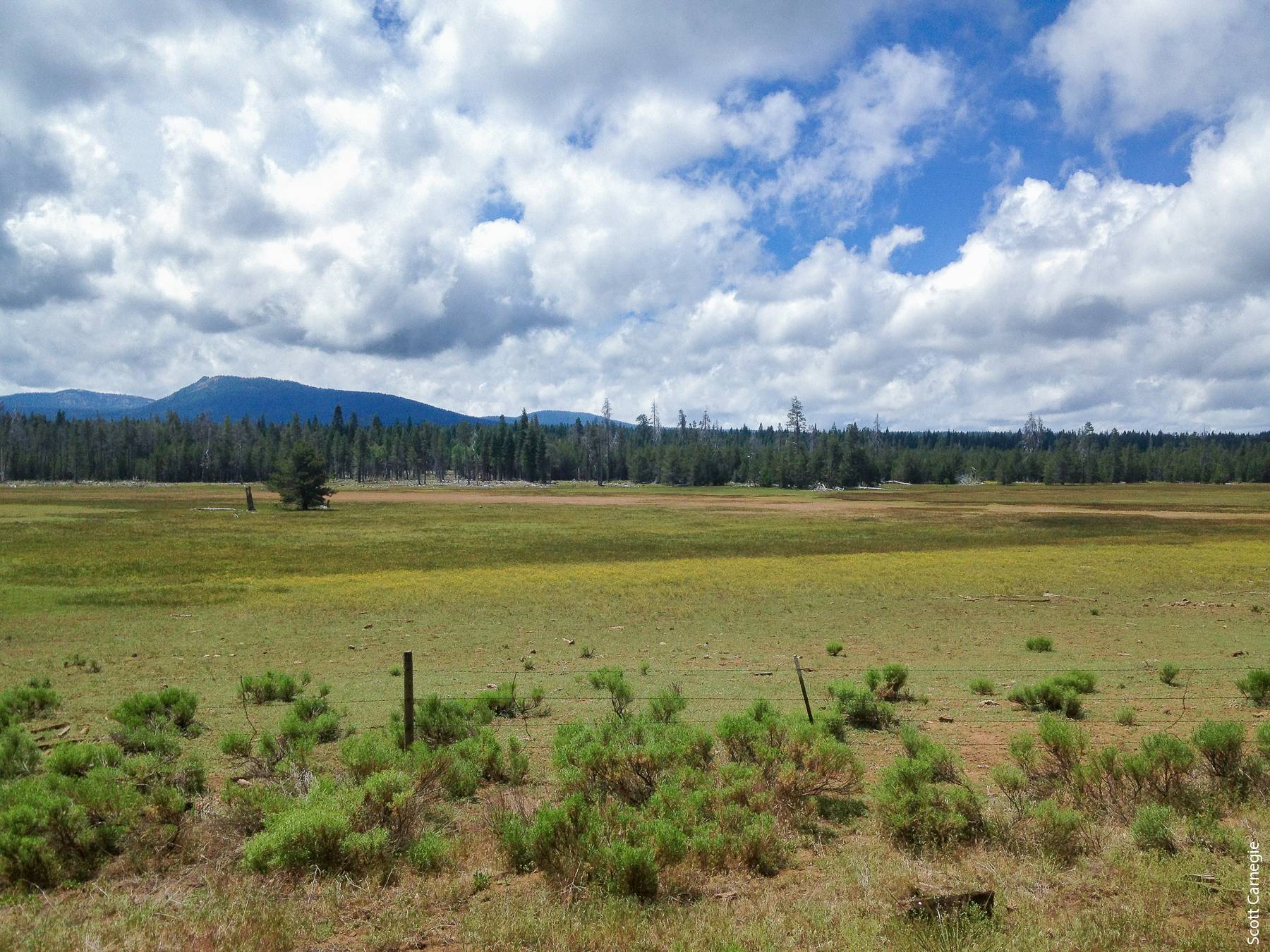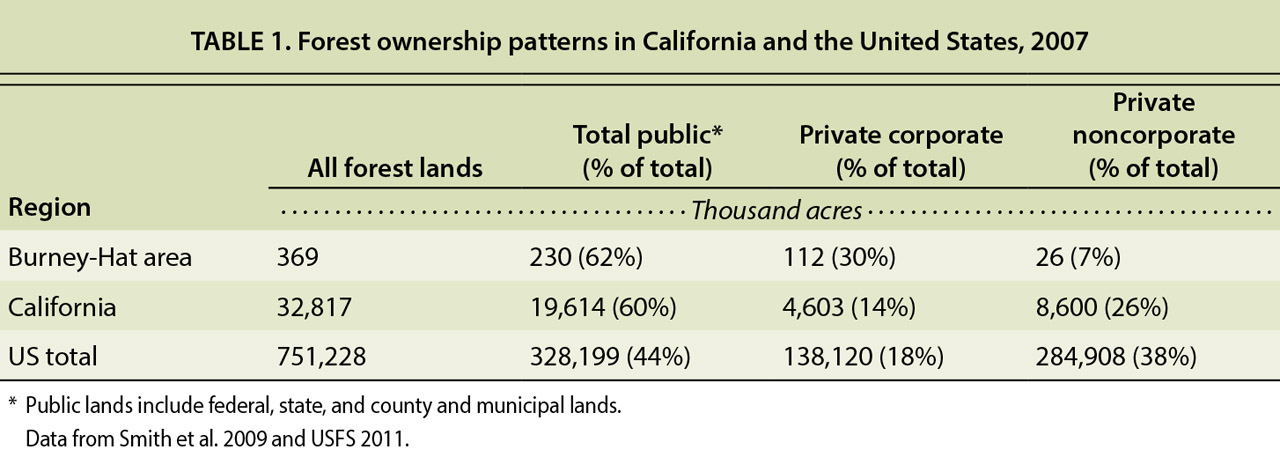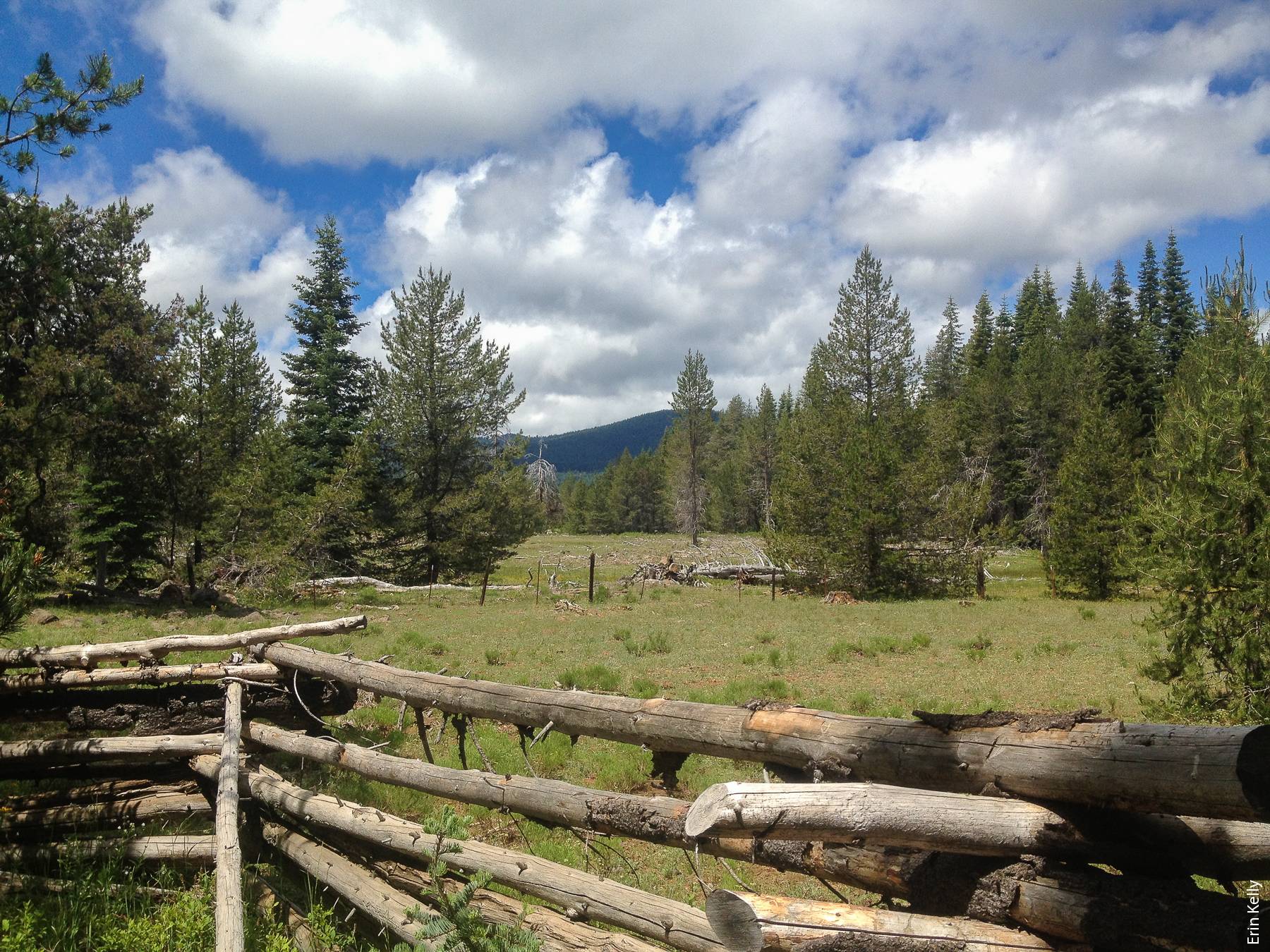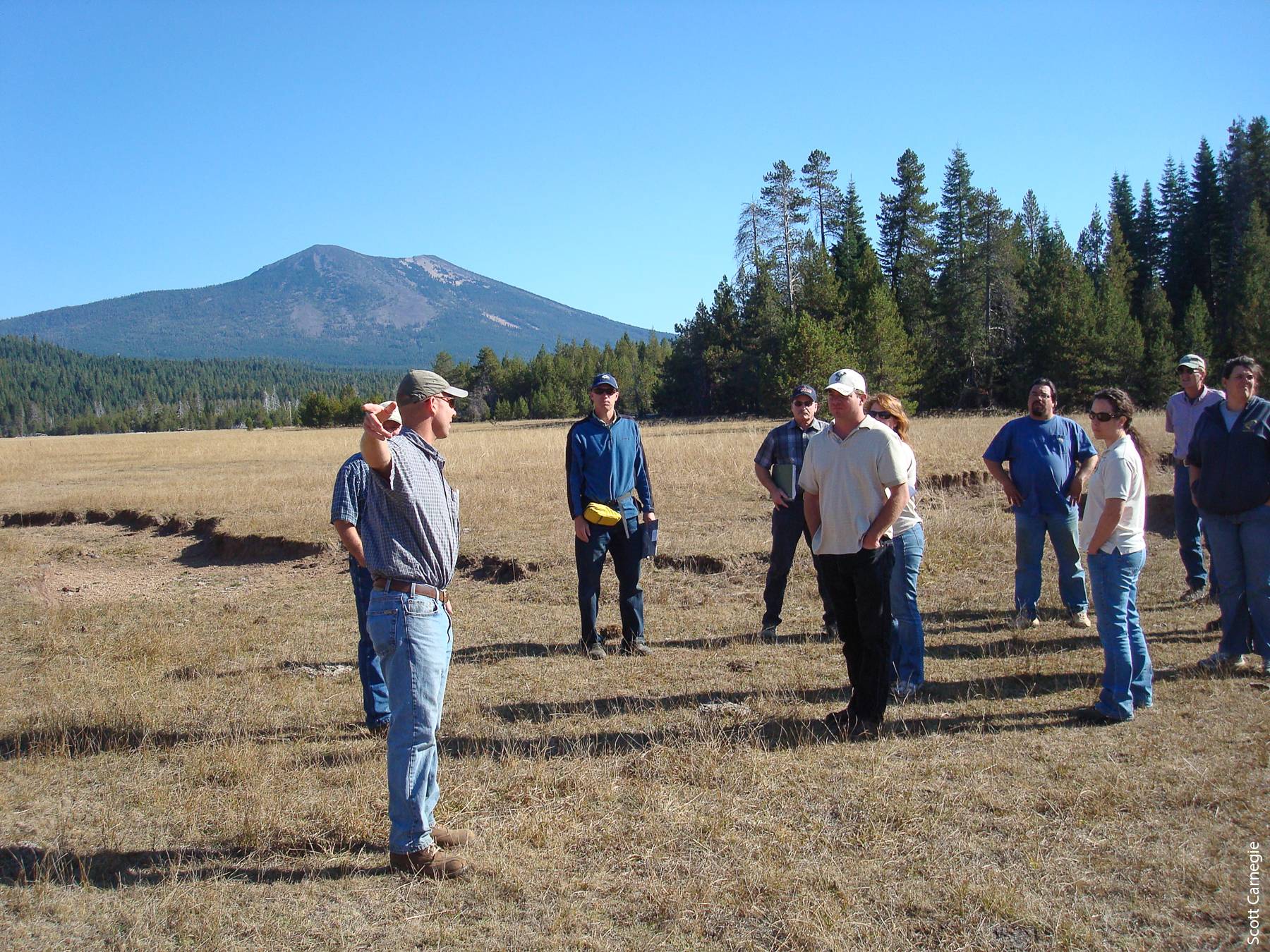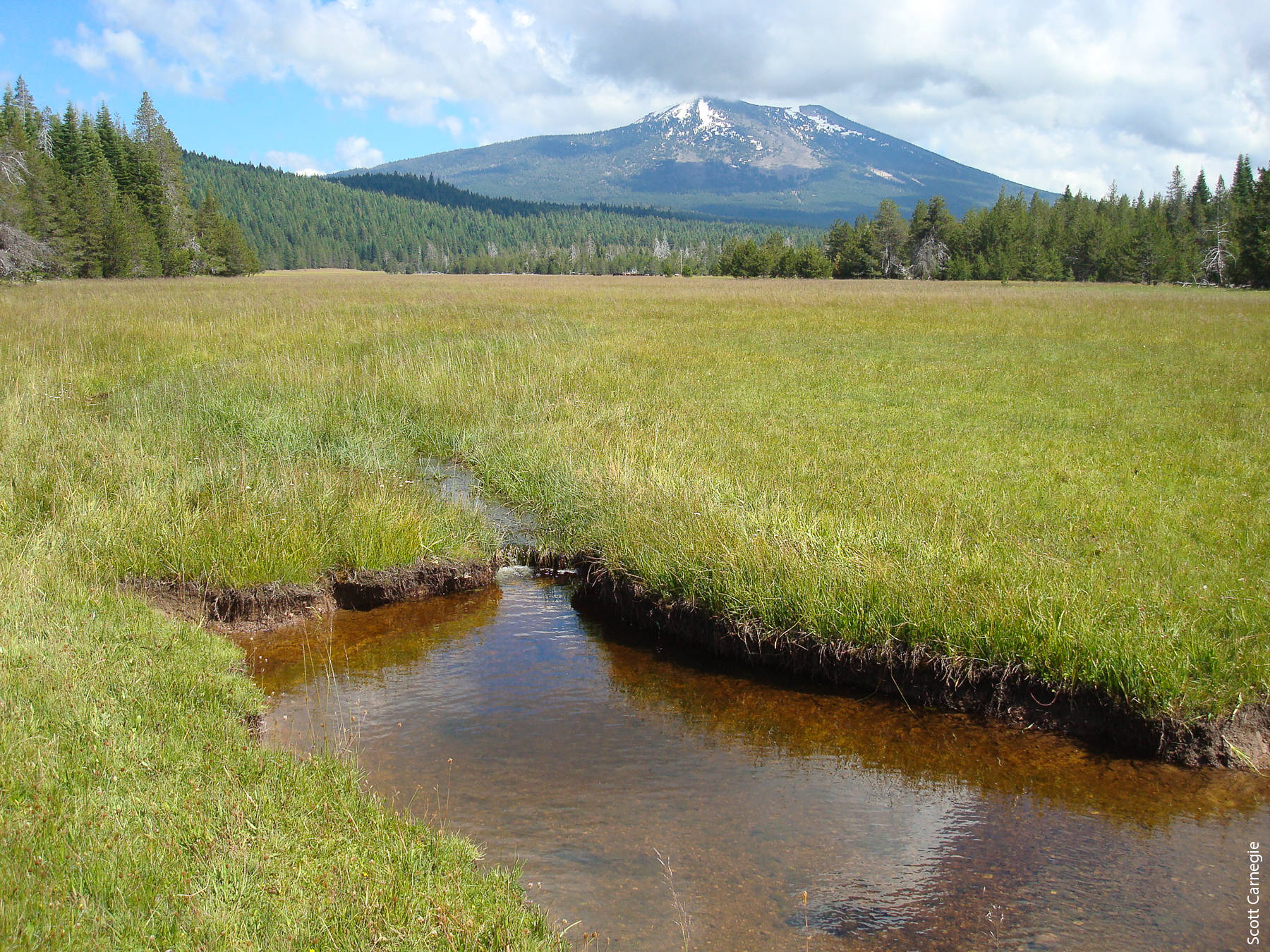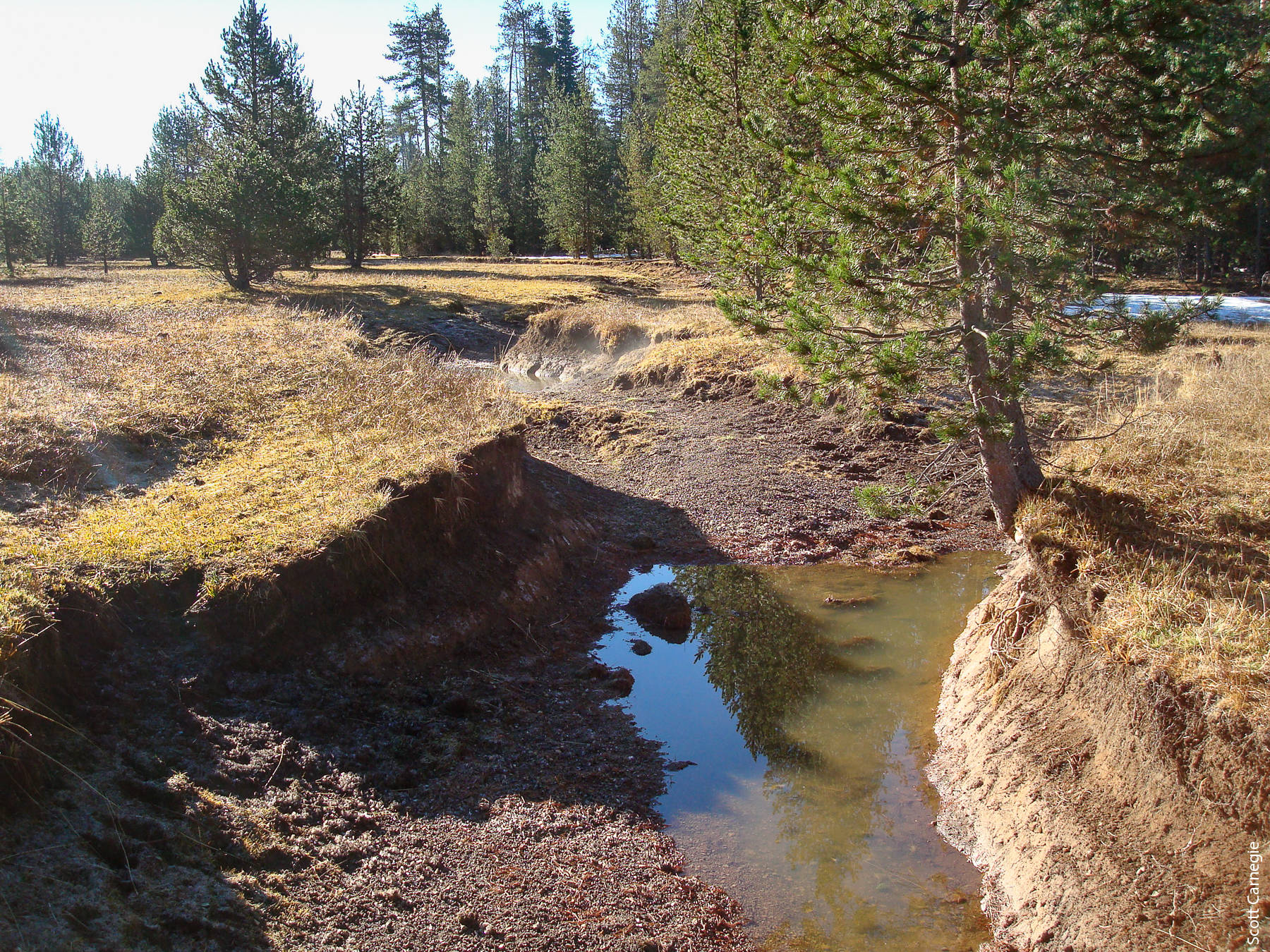All Issues
Cooperative, cross-boundary management facilitates large-scale ecosystem restoration efforts
Publication Information
California Agriculture 69(1):50-56. https://doi.org/10.3733/ca.v069n01p50
Published online January 01, 2015
NALT Keywords
Abstract
In California and across the United States, landscape restoration projects often require cross-boundary cooperation, though successful examples are rare and not well understood. This case study describes the Burney Gardens timber harvesting plan, a cooperative, cross-boundary meadow restoration project undertaken by private corporate forest landowners in Northern California as part of a larger collaborative restoration effort. The project is notable because it (1) received institutional support — both financial and political — from federal, regional and local sources and (2) engaged a diverse group of stakeholders in pre-project planning with multiple agency partners. This approach enabled the project plan to pass through the rigorous California regulatory system in an unusually rapid fashion despite its complexity. The collaborative model of the Burney Gardens project is relevant to other restoration efforts, particularly as diverse ownerships across the West implement large-scale projects that cross property boundaries, including those of federal and private lands.
Full text
Increasingly, large-scale restoration projects have become a priority for land managers in the United States, leading them to look beyond reserved lands (e.g., national parks) to the mix of private and public lands that characterize many watersheds (Lindenmayer and Franklin 2002). Policies at the state and federal levels have begun to address cross-boundary management — management that occurs across lands owned by different entities, with treatments implemented regardless of ownership type — facilitating both grassroots-based cooperative institutions, such as watershed councils (Rickenbach et al. 2011), and policies aimed directly at federal land managers, such as the 2009 U.S. Forest Service Collaborative Forest Landscape Restoration (CFLR) Program. U.S. Department of Agriculture Secretary Tom Vilsack stated that the U.S. Forest Service must work on restoration across property boundaries in an “all-lands approach” (USDA 2009), pointing toward the importance of land management that transcends ownership boundaries. Examples of successful cross-boundary restoration projects, however, are limited because of disparate environmental policies, economic motivations and resource (financial, technological, etc.) capacities of different ownerships (Charnley 2006).
The Burney Gardens timber harvesting plan (THP) is a cross-boundary, cooperative restoration plan developed by four private forest landowners in Northern California (Shasta County) that are part of a CFLR group. The THP was developed to restore a degraded meadow system being encroached by lodgepole pine (Pinus contorta), now growing in overstocked conditions as a result of fire suppression. Watercourses within the THP are degraded due to channelization and loss of riparian vegetation; this has resulted in erosion and insufficient shade. The Burney Gardens THP is now one of the largest watershed and meadow restoration projects ever proposed in California; restoration treatments include removal of lodgepole pine from the meadow as well as channel restoration. Some treatments have begun, such as thinning treatments around edges of the meadow, though much work remains (hydrological treatments are expected to begin summer 2015).
The Burney Gardens timber harvesting plan, which covers over 2,500 acres of land held by four different owners, is one of the largest watershed and meadow restoration projects proposed in California.
The Burney Gardens THP is notable for multiple reasons: it engaged government agencies and other stakeholders in extensive up-front planning; it received the support of a variety of organizations; it fostered trust and shared norms among a diverse group of stakeholders; and it enabled the CFLR group to provide evidence of a successful project, which was necessary to fulfill CFLR program mandates and leverage further funding. Furthermore, the plan was approved by regulatory agencies in less than a month, a remarkable achievement for a timber plan in California, where such plans may take over 6 months from submission to approval. The THP and associated restoration work could have generated conflict among agency review team members and the general public; its success in fostering cross-boundary cooperation and winning rapid approval make it a model worth understanding.
Reasons for restoration
Forest ownership in the United States is multifaceted, with widely varying management motivations, financial considerations, governance structures and regulatory standards. In the United States, 56% of forestland is privately owned, and 44% is publicly owned. In California, like much of the West, public ownership is higher (table 1), totaling roughly 60%. The remaining 40% of forestland is private, with 14% owned by corporate (industrial and investor) entities, and 26% owned by noncorporate entities, or “family” forest owners. If coordinated restoration projects are to be successful, we must understand the conditions that encourage private landowners to work across property boundaries. This case study focuses on private corporate landowners, a group largely overlooked in previous studies on cross-boundary collaboration.
A number of studies suggest that private landowners are willing to work cooperatively for various restoration objectives (Creighton et al. 2002; Ferranto et al. 2013; Fischer and Charnley 2012; Jacobson 2002; Rickenbach et al. 2011). Most of these studies focus on hypothetical scenarios, asking landowners whether they would work across property boundaries rather than how they can create and implement projects that span ownerships. Importantly, most studies have focused on noncorporate forest owners, whose management motivations are widely recognized as multifaceted (e.g., Butler and Leatherberry 2004; Creighton et al. 2002).
Corporate landowners' motivations are less well studied and typically described in terms of economic optimization and return on investment (e.g., Wigley and Sweeney 1993), which suggests that corporate landowners have little interest in cross-boundary restoration projects. In one of the few studies to present an alternative perspective, Brody et al. (2006) surveyed representatives of 38 forest companies and found a variety of reasons for participating in restoration projects, including building relationships and trust with outside stakeholders, avoiding litigation and increasing personal satisfaction for managers.
Private forest planning in California
THPs are the key environmental documents through which forest managers secure approval for private timberland management in California; Burney Gardens project collaboration took place largely through this permitting mechanism. The plans are developed according to the California Forest Practice Rules, which regulate forestry in the state through one of the most rigorous private forest regulatory frameworks in the world (McDermott et al. 2007). THPs are written by foresters certified by the state of California and provide an opportunity for public input on private forest management projects.
As part of the approval process, THPs are reviewed by multiple state agencies, including the Department of Forestry and Fire Protection (Cal Fire), regional water quality control boards and the California Department of Fish and Wildlife. In a majority of cases, a preharvest inspection is required, wherein the multi-agency review team assesses a plan in the field. Questions are directed to the forester, who is obligated to “satisfactorily” respond to these questions prior to Cal Fire's approval of the plan. A THP is often subjected to several rounds of reviews, each typically requiring modifications.
The Burney Gardens project was the first THP to take advantage of a 2012 change in the Forest Practice Rules called the Aspen, Meadow, and Wet Area Restoration rule modification (Aspen and Meadow Rule). This rule was implemented in part because landowners and stakeholders from the Burney Gardens region identified regulatory hurdles to meadow restoration projects. The new rule was developed in recognition of changes to natural disturbance processes, particularly fire suppression, that resulted in conifer encroachment in meadows, such as those in the southern Cascade region of Burney Gardens. These meadows provide vital habitat and maintain hydrologic processes and water quality, and approximately 40% of all meadows in the region are located on privately owned lands and under the purview of the California Forest Practice Rules (Gross and Coppoletta 2013).
Under the new Aspen and Meadow Rule, managers were allowed to bypass Forest Practice Rules requirements for conifer regeneration such as size restrictions (generally 40 acres) and adjacency restrictions, which prohibited adjacent clear-cuts for 5 years. In large meadow restoration projects like Burney Gardens, these requirements previously limited treatment size and forced landowners to submit THPs with “alternative prescriptions” that were time-consuming and costly (BOF 2011). The new rule created a more time-and cost-efficient process with the goal of promoting large-scale restoration.
In 2012, the Forest Practice Rules were modified in recognition of changes to natural disturbance processes, such as fire suppression, that led to conifer encroachment of meadows. The new rule was implemented in part because landowners and stakeholders from the Burney Gardens region identified regulatory requirements that hindered large meadow restoration projects.
Interviews with stakeholders
The authors participated in meetings for the Burney-Hat Creek Community Forest and Watershed Collaborative Group (Burney-Hat Group) and its private land subcommittee, which developed the Burney Gardens THP. The second author initially worked to bring together the Burney-Hat Group and encouraged state agencies to work with landowners to develop an all-lands project and THP.
We conducted interviews (n = 16) with the land managers for the private forest companies (n = 4), and with state and federal agency personnel (n = 9), funding agencies (n = 1) and other collaborative group members (n = 2). We selected interviewees based on their involvement in the Burney-Hat Group or because of their participation in the Burney Gardens THP. Interviews were semi-structured and topics depended on interviewee expertise, regarding either (1) the creation of the Burney Gardens THP, (2) the role of Burney-Hat Group in supporting the THP or (3) the creation of the Aspen and Meadow Rule. Interviewees were contacted in person or via email. During interviews, notes were taken, and were later transcribed and then analyzed through coding for thematic content per Strauss and Corbin (1998). Coding was done using NVivo software (QSR International, Doncaster, Australia) with codes assigned to interview segments to organize and understand interview data.
Burney Gardens THP development
The Burney Gardens THP encompasses a large, mixed-owner acreage, totaling 2,530 acres — about five times the average size of a THP for the region (Thompson and Dicus 2005). Conifers, mostly lodgepole pine, had encroached 1,360 acres of meadow, leaving only 140 acres without lodgepole intrusion. The THP called for removal of conifers from the meadow, and single-tree selection harvest (the removal of individual trees in commercial operations) of forested lands from the remaining 1,170 acres.
Though all four landownerships involved in the THP are corporate, their ownership structures are diverse. Sierra Pacific Industries is industrial, with both forest products facilities and timberland; Pacific Gas and Electric and Fruit Growers Supply Co. own timberland as single components of larger corporate structures; and W.M. Beaty is a consulting forestry group that manages land for other landowners. A consulting forester under contract to W.M. Beaty wrote the Burney Gardens THP.
Funding and institutional support.
In 2009, the Shasta County Resources Advisory Committee (RAC), established under the Secure Rural Schools and Community Self-Determination Act (H.R. 1424 §601), recommended funding for development of a collaborative group that would succeed in implementing forestry projects across several key watersheds without regard to land ownership. The RAC wanted to launch a “legacy project” to continue to advance its work on a larger scale and in a more comprehensive manner. This new collaborative became the Burney-Hat Group and was organized by Todd Sloat, watershed coordinator for the Fall River Resource Conservation District, with help from the U.S. Forest Service Hat Creek district ranger and the second author. Membership included environmental, corporate, tribal and governmental stakeholders.
The Burney Gardens THP was one of the first projects to receive support from the Burney-Hat Group; initial work on the plan began soon after the group was launched. The group's support resulted in RAC funding for THP development and generated political backing from the community for the project, which helped alleviate distrust between traditional opponents, such as members of environmental nonprofits and corporate forest managers. One corporate land manager said the project succeeded because of the community's support, and a member of an environmental nonprofit who was wary of many logging projects attributed the THP's success to the work of the landowners who “got together for the sake of the meadow.” In addition, there was broad consensus within the group about the need for tree removal to restore the meadow (Burney-Hat Group 2011).
Participants from the Burney-Hat Group indicated that previous restoration efforts, especially on public lands, were not fruitful and caused frustration for neighboring landowners and stakeholders. A participating forester stated, “Rather than just sit there and plan, talk to ourselves, we needed something tangible.” Most interviewees indicated that the Burney Gardens THP was a model for future projects. According to one representative of an environmental nonprofit, “We want it to be a good example of what a restoration project should look like.” As likelihood of project success increased, the project grew from a few hundred acres to its final size of over 2,500 acres.
In addition to the catalytic RAC funding, Burney Gardens THP development received support from state agencies including Department of Conservation and Sierra Nevada Conservancy; federal agencies including Natural Resource Conservation Service and U.S. Fish and Wildlife Service; and the private lands manager and utility company Pacific Gas and Electric. The THP cost about $90,000 to prepare, which included biological and archaeological assessments and document preparation, along with hydrologic restoration planning and permitting.
The Burney-Hat Group used the Burney Gardens THP to demonstrate that it could work across ownership boundaries. In 2011, the Burney-Hat Group won the Region 5, U.S. Forest Service Regional Forester's Award for All Lands Management. In early 2012, the Forest Service designated the Burney-Hat Group and the Lassen National Forest's Burney and Hat Creek landscape (369,000 acres total) as one of three CFLR projects in California. As part of this designation, the Burney-Hat Group received $10 million to be spent over 10 years for landscape restoration on national forest and adjacent private lands, and for improvement of community socioeconomic health. In this manner, the Burney Gardens project leveraged support and expanded landscape restoration possibilities.
Regulatory agencies and THP process review.
The process review for development of the THP demonstrates the extent of upfront, pre-project planning that was both unusual and essential to its success (fig. 1). In contrast to the process for a typical THP, in which a forester submits a plan to Cal Fire and then receives and responds to suggestions from multiple regulatory agencies, the Burney Gardens THP grew out of a July 2011 meeting called by the Burney-Hat Group working with the central Sierra–based Amador Calaveras Consensus Group and the Sierra Nevada Conservancy. State and federal agencies were asked to participate in this meeting to discuss advancing all-lands work. Burney-Hat Group members contacted review agencies directly to ask whether they would engage in pre-consultation discussions and organized field trips to inform development of the THP (fig. 1). With support from a Cal Fire deputy director, who had at the July meeting agreed to participate, other agencies joined the field trips and discussions. Site visits with land managers and agency staff continued through the fall of 2011.
Fig. 1. The top row illustrates a typical THP review process, with multi-agency reviews of submitted plans. The second row illustrates an upfront process, with agency input into plan creation.
Members of the Burney-Hat group organized field trips and discussions with government agencies to inform development of the THP. The direct meetings and informal relationships that developed over time contributed to trust and, ultimately, the ability of both private landowners and agency personnel to effectively work together.
The passage of the Aspen and Meadow Rule, coupled with support from mid- to high-level officials within the regulatory agencies, provided impetus to local agency personnel to engage with and support the Burney Gardens THP. Instead of responding to comments from agencies after the bulk of planning was completed, foresters were able to incorporate agency concerns into plan development. Moreover, the direct meetings and informal relationships developed over time contributed to trust and, ultimately, the ability of both private landowners and agency personnel to effectively work together. Although upfront work for the THP was extensive and involved more field visits than a typical THP, interviewees felt it resulted in a better plan and proved to be more efficient than the typical review process.
Local biomass capacity.
For the private land managers, a shared sense of the need to manage the land base and mutual familiarity with timber management and planning made partnership work. However, the meadow restoration described in the Burney Gardens THP can only be realized if the THP is fully implemented, and as of winter 2015 there remain several barriers to completing the work, as well as future all-lands work in the Burney-Hat landscape. Approximately 113 acres of single-tree selection have occurred thus far, but none of the meadow restoration work has been completed.
The most significant barrier for Burney Gardens as of 2015 is the lack of biomass capacity in the local area. Small diameter material removed from restoration projects such as the Burney Gardens THP has limited economic value. Two active biomass facilities remain in close proximity to the project area, but only one accepts biomass from outside entities. The amount of material generated by the Burney Gardens project is expected to saturate the limited local market, depressing prices that are already low. With limited economic utility for biomass material, less restoration is possible.
New policy directions
The Burney Gardens THP demonstrates that large-scale restoration projects can be successfully developed on private lands involving multiple owners — in this case, multiple corporate-owned private forestlands. The circumstances surrounding the creation of the Burney Gardens THP point toward policy directions to facilitate cross-boundary management, in particular (1) nested, multi-scaled institutional support at the regional, state and federal levels and (2) coherent, upfront project planning.
Corporate landowner motivations.
Like Brody et al. (2006), we found motivations for restoration that encompassed more than economic optimization. Clewell and Aronson (2006) described five types of landowner motivations for restoration, including technocratic, in which legal requirements mandate restoration activities; biotic, such as biodiversity protection; heuristic, in which restoration is educational; idealistic, in which humans seek to atone for degradation; and pragmatic, in which ecosystem services are valued and enhanced. Corporate landowners' restoration objectives are typically driven by economic self-interest and technocratic, or law-abiding, motivations.
The Burney Gardens project showed that corporate landowner motivations can exceed narrow self-interest. While corporate landowners participated in part to convince the Forest Service to treat its overstocked forests as part of the CFLR program — resulting in reduced risk of fire moving from federal forests to their private lands — we also found that biotic and idealistic reasons were put forth by the corporate land managers in describing the project as “the right thing to do” to achieve a healthier landscape. Pragmatic reasons, such as water quality improvements and improved grazing, were also cited as important. Even heuristic reasons were cited as motivation for the project, as the corporate land managers wanted to demonstrate the efficacy of meadow restoration and the success of the collaborative group in moving from project concept to implementation.
These findings suggest that future restoration projects involving corporate landowners may encourage participation through more than legal requirements or economic incentives. Whether because of the landowners' desire for social license and approval from neighbors or because of individual managers' sense of stewardship, motivations for participating in joint landscape management and restoration are more complex than previously granted. There is need for additional exploration of the impetus behind corporate landowner behavior, especially to promote corporate landowners as partners in restoration projects within the all-lands management goals of the U.S. Forest Service.
Nested institutional support.
The creation of the Burney Gardens THP was successful because of a nested series of supportive institutions at multiple levels (from regional to federal), confirming previous findings (Epanchin-Neill et al. 2010; Ostrom 2012; Rickenbach et al. 2011). Epanchin-Neill et al. (2010) proposed bottom-up, middle-level and top-down institutions, each with different roles in a cooperative partnership, with middle-level organizations facilitating communication and mediating between the managers on the ground and governmental agencies. In this case, the Burney-Hat Group and the Fall River Resource Conservation District filled this middle-level role, which was further embedded in and supported by funding from the Shasta County RAC and the federal CFLR program. Within the state of California, the Burney-Hat Group was able to garner top-down support from several agencies, most notably Cal Fire. This support enabled agency personnel to take risks with an unusual THP review process that included unconventional practices and a comparatively large planning area.
The Burney Gardens THP is also an important example of garnering ground-level, local support. Many top-down restoration projects have faced hurdles because local voices have been excluded; for example, Barr and Sayer (2012) point to REDD+ projects in the developing world as marginalizing local communities, resulting in perverse incentives to degrade landscapes outside project areas. The Burney Gardens THP, on the other hand, is a rare attempt — with consent from corporate landowners and managers — to incorporate public input into private management action. Rather than simply offering a plan for comment, the Burney Gardens project was formulated with agency and Burney-Hat Group member participation. Restoration became a process of reintegrating people with their landscape, in contradiction to the view that ecological integrity exists in the absence of human management (Rikoon 2006). One result of Burney-Hat Group member inclusion was increased respect and support for private land managers, including improved understanding and respect for the hurdles they face.
Upfront planning.
The Burney Gardens THP demonstrates the power and efficacy of upfront planning. Rather than bringing in state agencies after THP completion, as is normally the practice, Burney Gardens THP involved agencies early in the project planning process. This early engagement, or pre-project consultation, laid the groundwork for communication and openness and subsequent integration of agency concerns into the plan that was submitted. Project designers were able to proactively address concerns through integrative discussions among multiple landowners and agency members, rather than leaving individual foresters to respond to agency comments after plan submission. Instead of trying to advance a project that would pass inspection but produce diminished restoration results, upfront and multi-stakeholder planning enabled the Burney THP to incorporate diverse goals and tackle multiple issues. The result was a coherent, large-scale restoration project that included both commercial timber production (through single-tree selection harvests) and meadow restoration.
These findings have implications for public land managers on federal lands, whose energies are too often focused on procedural issues associated with public processes mandated by with the National Environmental Policy Act (NEPA) and potential litigation. According to Mortimer et al. (2011), this situation has resulted in delayed decision making and led to excessive risk aversion within the agency. Upfront planning for NEPA documentation is a relatively new tactic for the U.S. Forest Service, which has long presented the public with pre-digested alternatives and a preferred option developed without stakeholder involvement. With upfront planning, the Forest Service could incorporate the views of stakeholder groups into its projects, potentially leading to a less adversarial NEPA process, successful project implementation and trust building for subsequent management projects.
Future research and next steps
As the all-lands approach is extended to more multi-jurisdictional landscapes, federal land managers will need to consider ways to support and integrate private landowner participation. Private landowners join collaborative groups when the benefits outweigh the costs of meeting and negotiating outcomes (Lubell et al. 2002). In this case, transaction costs were reduced through the creation of a supportive network of organizations that provided both funding and political backing for restoration, and extensive upfront planning that allowed the landowners to create a coherent and integrative restoration strategy rather than responding piecemeal to agency concerns.
Although the Burney Gardens project grew out of a multi-jurisdictional landscape group, the project remained focused on private land. Integrating private and federal land management is a needed next step, and one that will likely prove more difficult. The summer 2014 fires that burned tens of thousands acres in the CFLR area, including private land, will challenge and compel partners to not only work through frustrations as a result of losses associated with the fires, but differences in landscape objectives and practices. Though barriers to full completion remain, the Burney Gardens project offers the outlines of success that inform how to develop a more resilient landscape and contribute to socioeconomic vitality of nearby communities.



